The automotive world is rapidly embracing electric vehicles, yet hybrid technology continues to offer a practical stepping stone into electrification, especially for drivers not yet ready to commit to a fully electric lifestyle. For those seeking fuel efficiency without the need for charging infrastructure, hybrid crossovers present an appealing option. These vehicles combine the versatility of a crossover with the enhanced fuel economy of a hybrid powertrain, making them ideal for urban environments and beyond. In the 2025 model year, several compelling hybrid crossovers are hitting the market, and we’re diving deep into three of the most noteworthy contenders: the Mazda CX-50 Hybrid, the Hyundai Tucson Hybrid, and the Lexus UX300h. Each offers a unique blend of features, performance, and style, but which one emerges as the Best Hybrid Crossover for your needs? Let’s explore their strengths and weaknesses to help you decide.
Mazda CX-50 Hybrid: Refined Efficiency Meets Rugged Style
Mazda has long been known for its “zoom-zoom” driving dynamics, but with the CX-50 Hybrid, the focus shifts slightly towards efficiency without completely abandoning Mazda’s signature style. The CX-50, already known for its rugged aesthetic, receives a hybrid powertrain for 2025, borrowing Toyota’s highly regarded hybrid system. This collaboration brings together Mazda’s design prowess with Toyota’s hybrid expertise, creating a unique offering in the compact hybrid crossover segment.
Design and Powertrain: Toyota Hybrid Synergy
Underneath the CX-50’s distinctive and adventurous skin lies the heart of the Toyota RAV4 Hybrid. The CX-50 Hybrid utilizes the same 2.5-liter inline-four engine paired with Toyota’s Hybrid System (THS), delivering a combined output of 219 horsepower and 163 lb-ft of torque. This powertrain configuration, channeled through a continuously variable transmission (CVT) and standard electric all-wheel drive, mirrors the RAV4 Hybrid’s specifications. While this powertrain prioritizes efficiency, it’s worth noting that it offers more horsepower but less torque than the standard gasoline CX-50, and significantly less than the turbocharged variant. The CX-50 Hybrid positions itself as an efficiency-focused model within the CX-50 lineup.
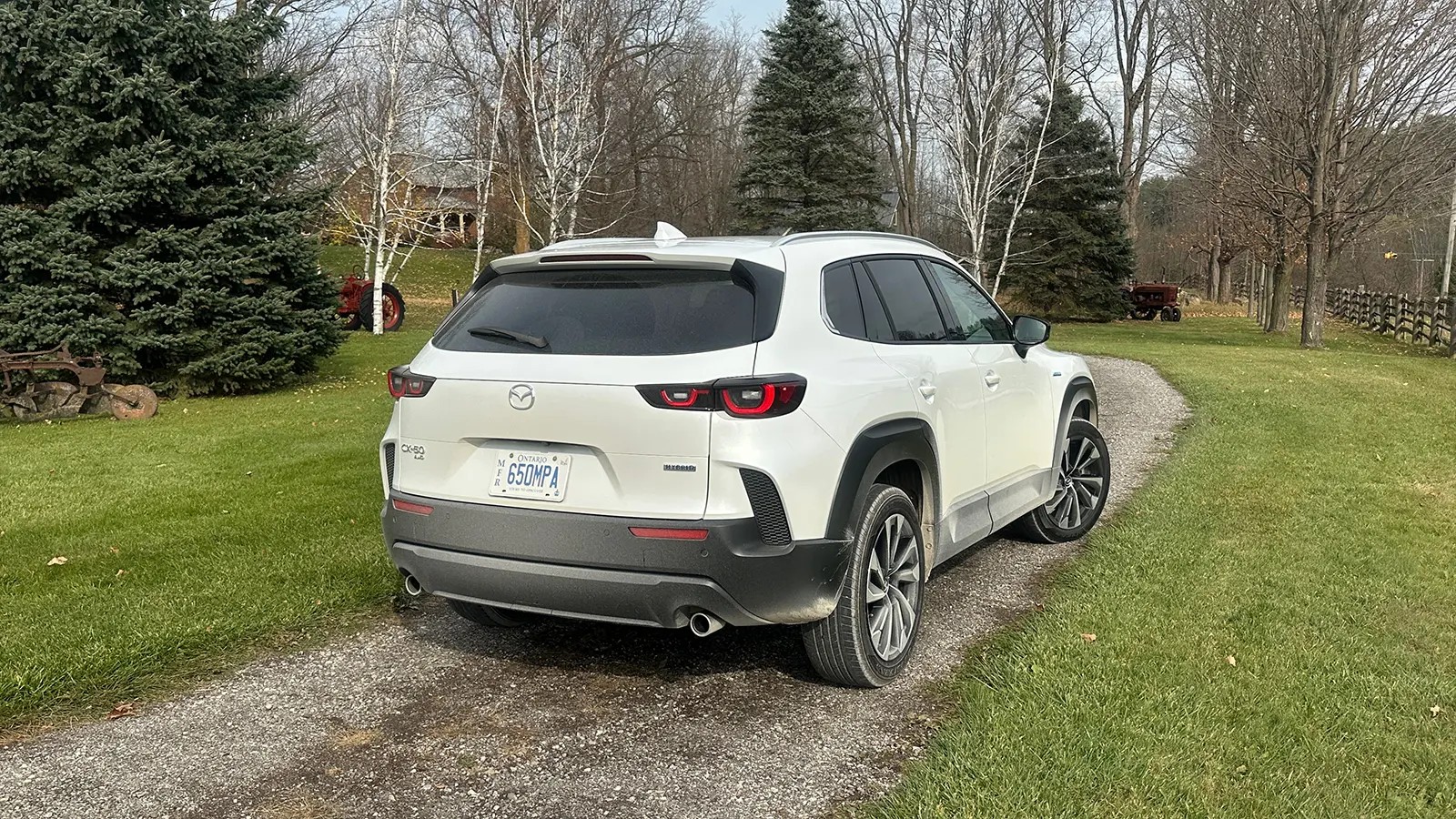 White Mazda CX-50 showcasing its rugged crossover design
White Mazda CX-50 showcasing its rugged crossover design
Fuel Economy and Practicality Adjustments
The Mazda CX-50 Hybrid achieves an EPA-estimated combined fuel economy of 38 mpg, a slight dip from the RAV4 Hybrid’s 39 mpg. Integrating the Toyota Hybrid System into the CX-50 required notable engineering adjustments. The body cladding is extended, and the roof is subtly raised to maintain a 7.6-inch ground clearance, even with the battery pack positioned under the rear seat. While the CX-50 Hybrid boasts a longer overall length compared to rivals, its cargo space is slightly reduced to 29.2 cubic feet, compared to 31.4 cu-ft in other CX-50 models and less than the RAV4 and Tucson Hybrids.
Interior Refinement and Features
Where the CX-50 Hybrid truly distinguishes itself is in its interior ambiance. Mazda has cultivated a subtly upscale environment, particularly in higher trim levels. The Premium Plus trim, for example, features two-tone leather seats with meticulous stitching, complemented by similar detailing on the doors and dashboard. A rotary controller in the center console, a feature often found in luxury vehicles, adds a touch of sophistication and reduces reliance on the touchscreen. Physical buttons for seat memory, camera, and parking sensor controls further enhance user-friendliness.
Despite these modern touches, the CX-50 Hybrid retains a hint of classic appeal. Analog gauges, a relatively small infotainment screen, and a lack of extensive LED accent lighting offer a more traditional feel. However, features like a panoramic sunroof and wireless smartphone integration are available, balancing modern needs with a classic aesthetic.
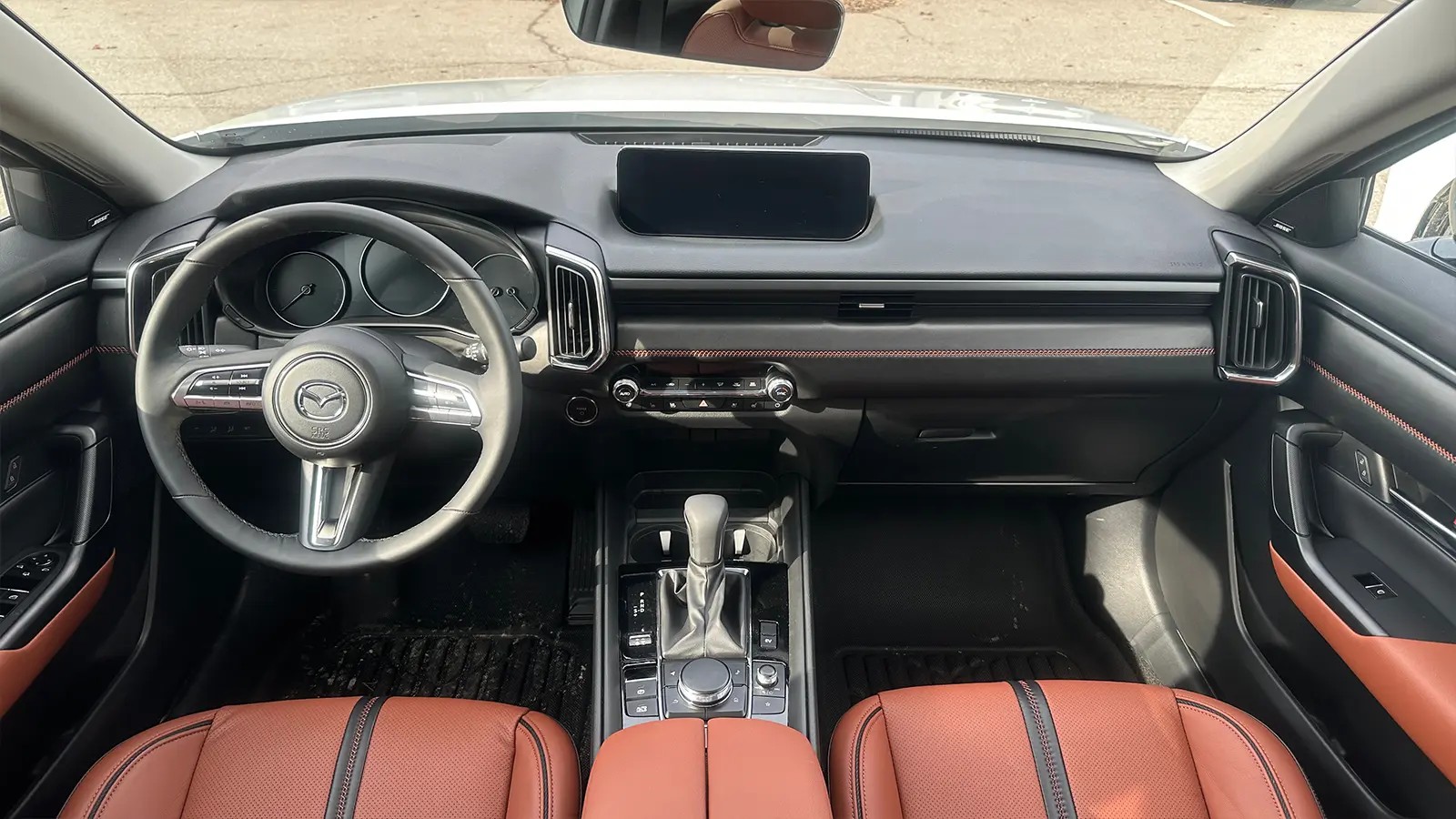 Mazda CX-50 Hybrid interior featuring leather seats and a rotary controller
Mazda CX-50 Hybrid interior featuring leather seats and a rotary controller
Pricing and Market Position
The Mazda CX-50 Hybrid is priced between $34,000 and $40,000 MSRP, positioning it above the standard gasoline CX-50 models but below the turbo variants. This mid-range placement reflects its focus on refined efficiency and a touch of luxury, differentiating it from the Hyundai Tucson Hybrid, which offers a broader spectrum of hybrid options, including sportier and more luxurious trims at similar price points.
Hyundai Tucson Hybrid: A Versatile Hybrid Crossover for Every Taste
Hyundai takes a more expansive approach with its Tucson Hybrid, offering a range of trims to cater to diverse preferences. From fuel-efficient models to sporty N Line versions and even a plug-in hybrid variant, the Tucson Hybrid provides a comprehensive selection within the compact hybrid crossover segment. This broad strategy aims to capture a wider audience, appealing to those seeking economy, performance, or a blend of both.
Trim Levels and Design Refresh
The Hyundai Tucson Hybrid lineup includes gas-only, sport-oriented N Line, and luxury-focused hybrid trims, along with a plug-in hybrid (PHEV) option. The PHEV variant caters to drivers seeking electric driving capability for shorter commutes with the security of a gasoline engine for longer journeys. For 2025, all Tucson models receive a refreshed front fascia with updated LED lighting and wheel designs, enhancing its modern and distinctive styling. The Tucson’s sharper lines contrast with the more rounded aesthetics of some competitors, giving it a contemporary edge.
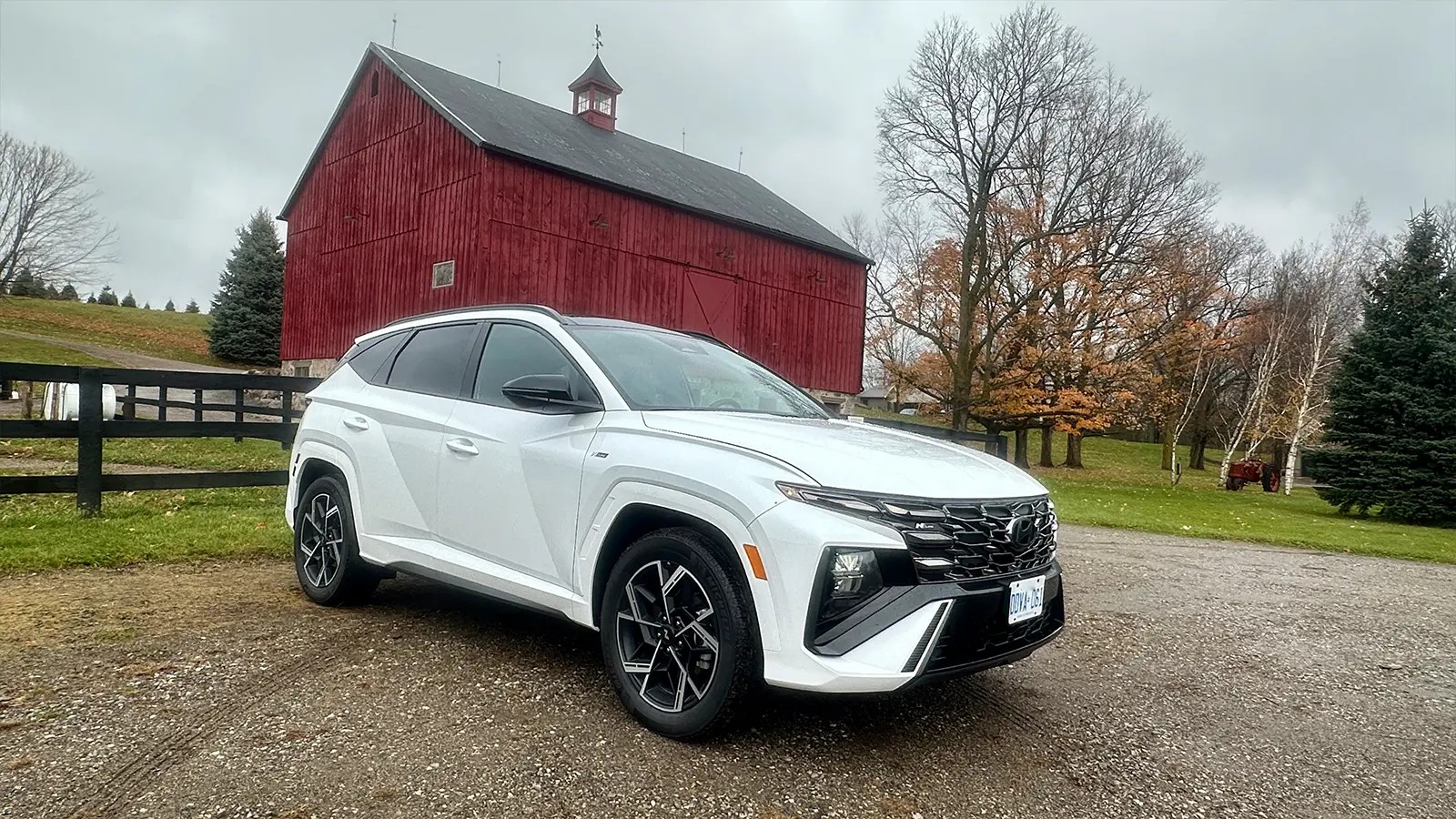 White Hyundai Tucson Hybrid showcasing its redesigned front end
White Hyundai Tucson Hybrid showcasing its redesigned front end
Sporty N Line Interior and Features
The Tucson Hybrid N Line model distinguishes itself with 19-inch wheels, black exterior accents, and unique N Line badging. Inside, the N Line trim features a modern, all-digital dual-screen display, replacing traditional analog gauges. Red stitching accents throughout the cabin, sporty seats, and metal pedals amplify the N Line’s sporty character. The steering wheel, adorned with the N logo, further emphasizes its performance-oriented intentions.
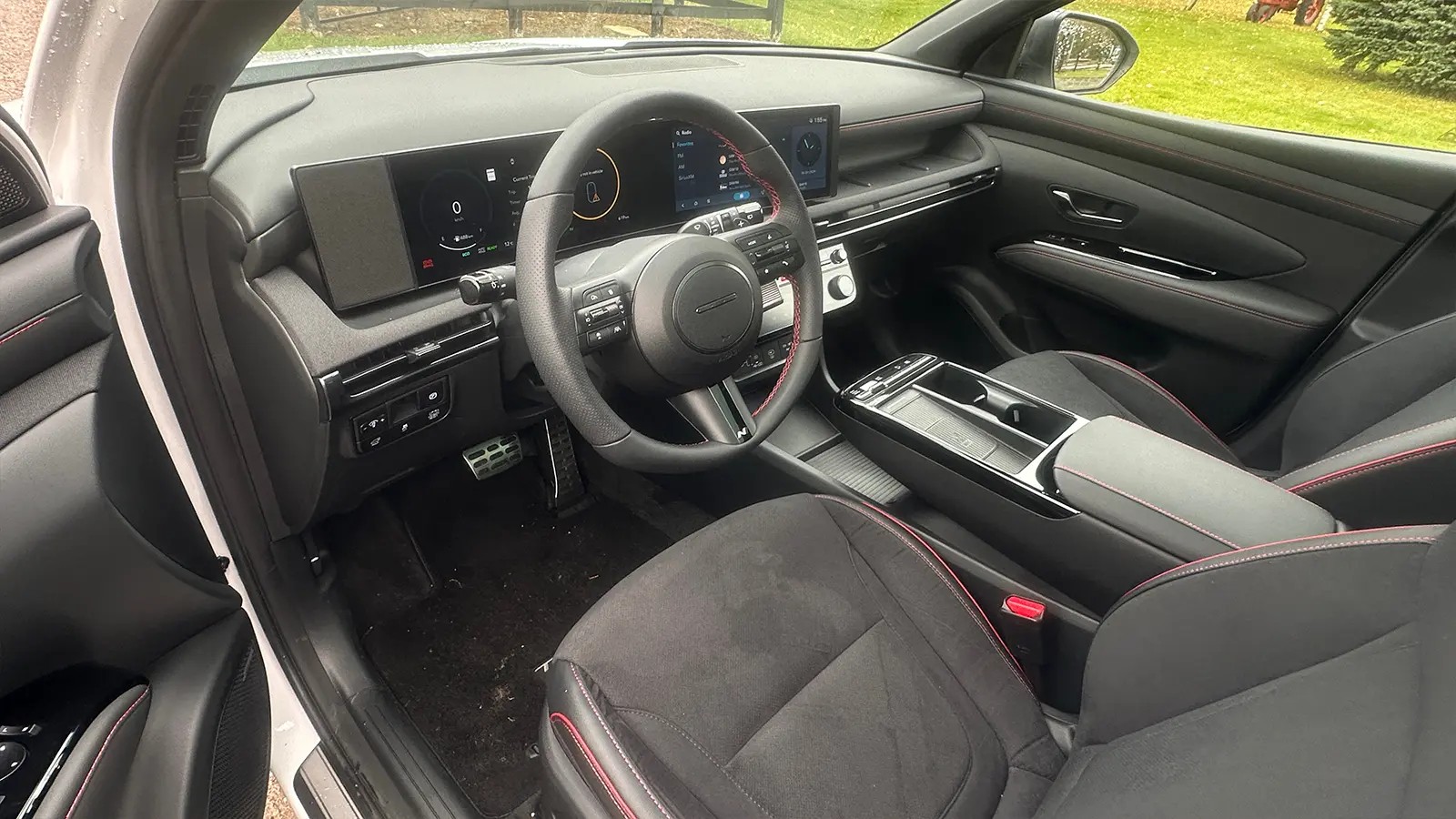 Hyundai Tucson Hybrid N Line interior with dual screens and red accents
Hyundai Tucson Hybrid N Line interior with dual screens and red accents
Performance and Efficiency Balance
The Tucson Hybrid N Line is powered by a 1.6-liter turbocharged engine, delivering a combined 231 horsepower and 258 lb-ft of torque when using premium fuel. While it can run on regular fuel, premium fuel maximizes performance. A traditional six-speed automatic transmission with paddle shifters provides a more engaging driving experience compared to the CVTs found in the Mazda and Lexus. While not the most fuel-efficient in its class at 35 mpg combined, the Tucson Hybrid N Line offers a compelling balance of performance and efficiency, providing more spirited acceleration and passing power. The powertrain feels refined, even compared to some luxury brand hybrids.
Despite its sporty N Line designation, the Tucson Hybrid maintains a comfortable ride, similar to the Tucson XRT soft-roading trim. It also includes practical features like “Baby Mode,” which softens acceleration for passenger comfort, highlighting its family-friendly nature alongside its sporty appeal.
Practicality and Space Advantages
The Hyundai Tucson Hybrid excels in practicality, offering more rear-seat room and cargo space than the Mazda CX-50 Hybrid. This makes it a more family-friendly option, providing ample space for passengers and luggage. Its larger cargo area adds to its versatility, making it suitable for a wider range of needs.
Lexus UX300h: Urban Luxury in a Compact Hybrid Package
The Lexus UX300h represents the luxury offering in this comparison, though it occupies a slightly smaller footprint than the Mazda and Hyundai. For 2025, the UX250h has been renamed UX300h, reflecting updates and enhancements. The UX300h emphasizes urban maneuverability and Lexus’ signature luxury, but its smaller size and powertrain characteristics place it in a unique position within the compact hybrid crossover segment.
Size and Urban Focus
The Lexus UX300h is classified as a compact car by fueleconomy.gov, while the Mazda and Hyundai are categorized as small SUVs. The UX300h leans more towards a subcompact crossover or hatchback in size. Its smaller dimensions offer advantages in urban environments, particularly in parking and maneuverability. While it may not be a direct competitor in terms of size to the Tucson and CX-50, its pricing overlaps, making it a potential option for buyers considering luxury and fuel efficiency in a smaller package.
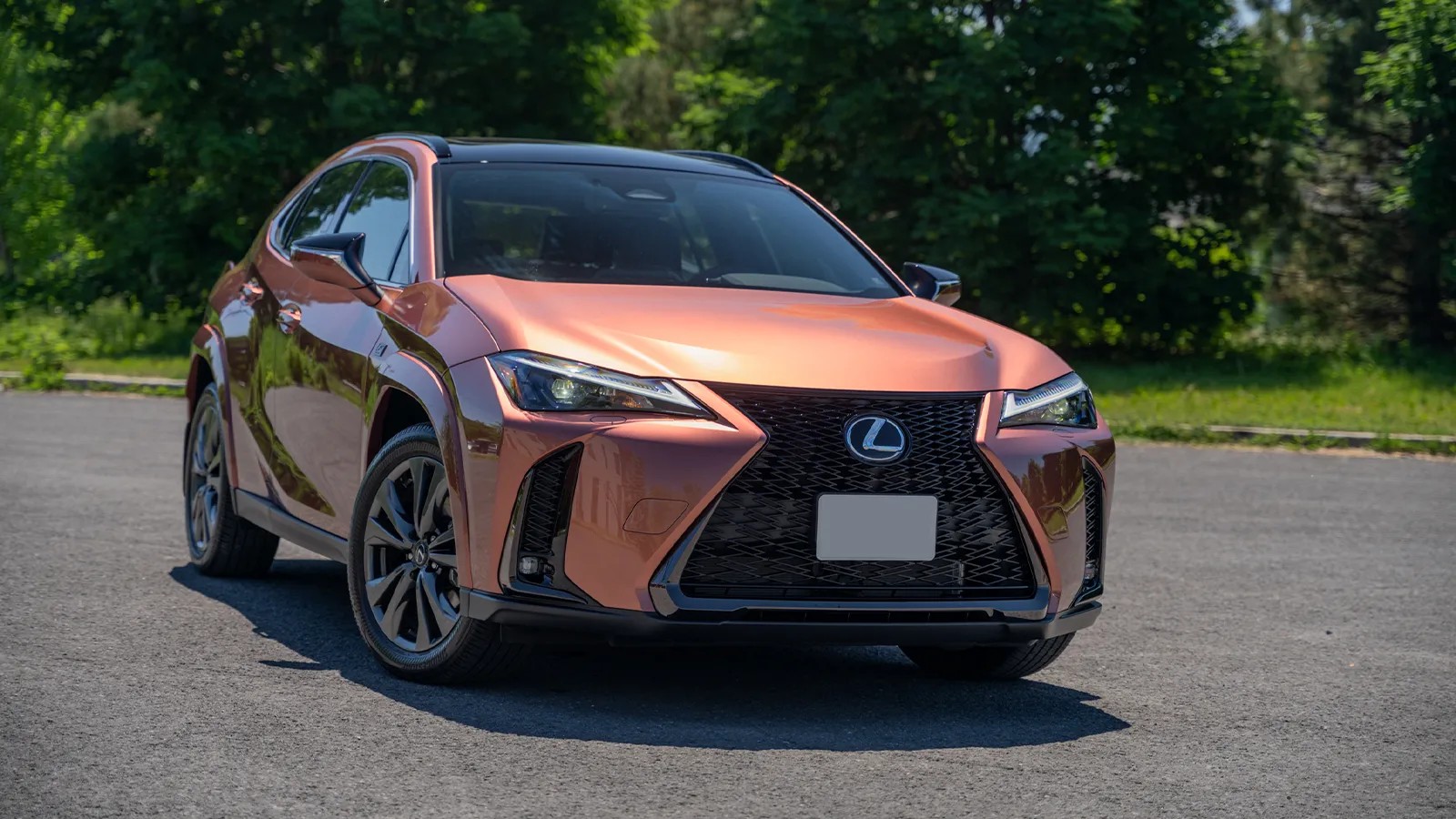 Orange Lexus UX300h highlighting its compact size and urban appeal
Orange Lexus UX300h highlighting its compact size and urban appeal
Design and Luxury Features
The Lexus UX300h boasts distinctive Lexus styling, particularly in the F Sport trim, which adds unique wheels, a prominent grille, a black roof, and roof rails. While some may find the large grille polarizing on a smaller vehicle, the UX300h generally presents an attractive and upscale appearance. The interior materials, design, and infotainment system in the UX300h meet Lexus’ high standards for luxury and refinement. Front-seat comfort is comparable to the larger crossovers, though rear passenger and cargo space are more limited due to its smaller size. The UX300h offers significantly less cargo capacity at 17.2 cubic feet, less than half of the Tucson’s cargo volume.
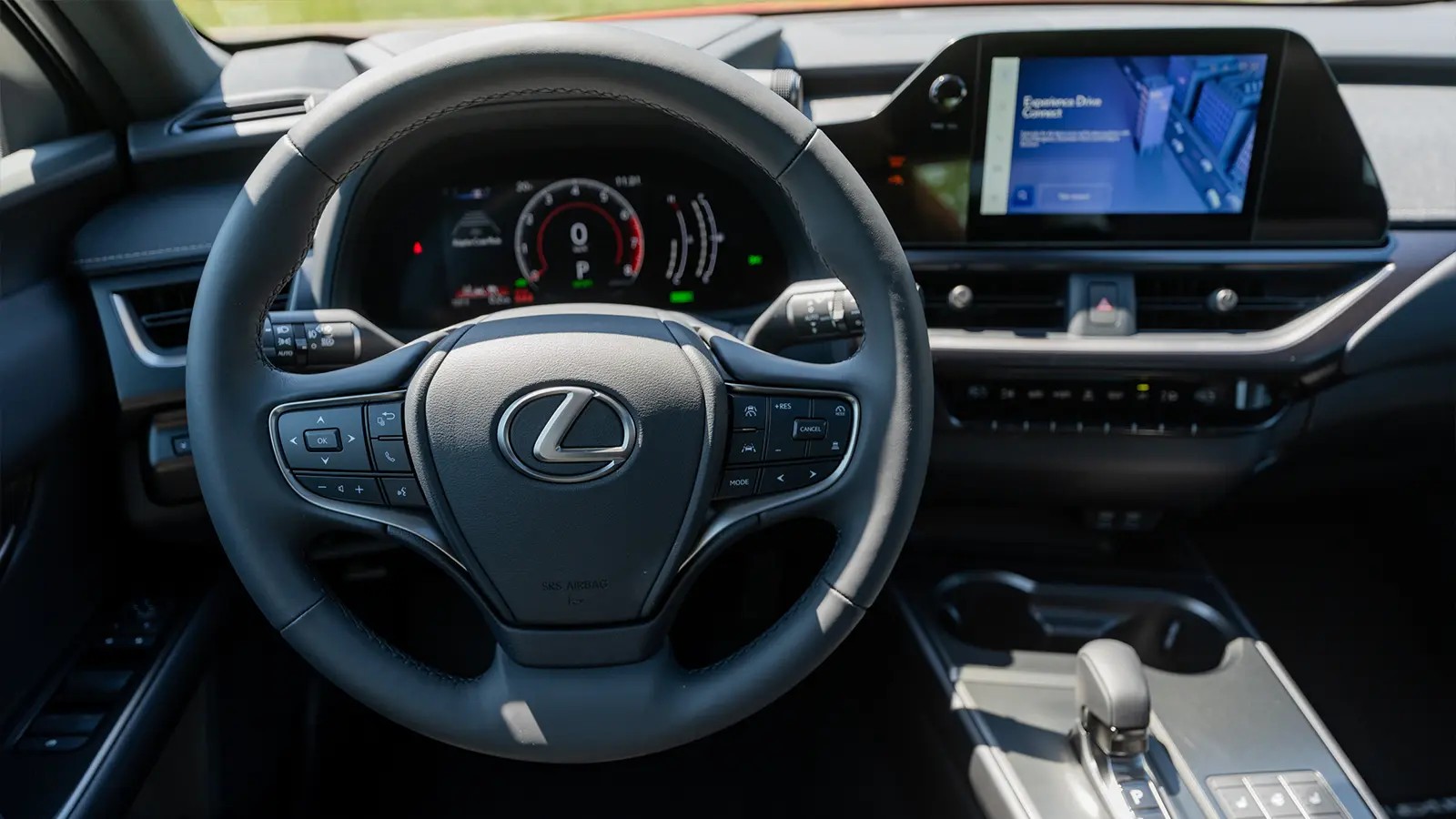 Lexus UX300h interior showcasing luxury materials and infotainment screen
Lexus UX300h interior showcasing luxury materials and infotainment screen
Updated Hybrid System and Performance
The UX300h features an updated fifth-generation hybrid system with a shift-by-wire CVT and a larger lithium-ion battery, a first for Lexus hybrids. Power output is increased to 196 horsepower, and fuel economy is impressive at 42 mpg combined for AWD models and 43 mpg for FWD models. However, the engine’s noise and harshness remain noticeable, contrasting with Lexus’ typically hushed cabin environments.
Pricing and Value Proposition
The Lexus UX300h starts at $37,515 for the front-drive model and $43,035 for the F Sport AWD version. While priced higher than the base Mazda and Hyundai hybrids, the UX300h offers a more luxurious interior and the Lexus brand experience. However, the trade-off is less interior space and a powertrain that, while efficient, may not be as refined as expected in a Lexus.
Conclusion: Choosing the Best Hybrid Crossover for You
Each of these hybrid crossovers – the Mazda CX-50 Hybrid, Hyundai Tucson Hybrid, and Lexus UX300h – presents a unique set of strengths and weaknesses. The Mazda CX-50 Hybrid offers refined efficiency and rugged styling, appealing to those who value design and a touch of luxury. The Lexus UX300h provides a compact luxury hybrid experience, ideal for urban dwellers prioritizing maneuverability and brand prestige.
However, when considering the overall package, the Hyundai Tucson Hybrid emerges as a standout choice. It strikes an excellent balance of practicality, sportiness, and modern design. Its versatile trim levels, spacious interior, and engaging driving dynamics make it a compelling option in the best hybrid crossover segment. The Tucson Hybrid’s ability to blend family-friendly features with sporty appeal, wrapped in a contemporary design, positions it as a top contender for drivers seeking a well-rounded and future-proof hybrid crossover as the automotive landscape continues its shift towards electrification.
*All mileage claims are EPA estimated.
